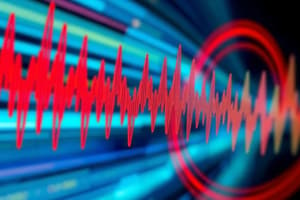Podcast
Questions and Answers
What is the primary purpose of the enrolment phase in a speaker verification system?
What is the primary purpose of the enrolment phase in a speaker verification system?
- To collect background noise samples
- To compare voiceprints of different speakers
- To make a verification decision
- To extract features from the speaker's voice (correct)
Which factor is NOT considered when evaluating speaker verification systems?
Which factor is NOT considered when evaluating speaker verification systems?
- User's age and gender (correct)
- Variability between enrolment and verification speech
- Speech quality
- Noise level and type
In text-dependent recognition, what advantage does knowledge of the spoken text provide?
In text-dependent recognition, what advantage does knowledge of the spoken text provide?
- Increased security against impostors
- Greater system flexibility
- Ability to process longer speech durations
- Improved performance of the recognition system (correct)
Which speech modality allows for user-selected phrases?
Which speech modality allows for user-selected phrases?
What is a major challenge associated with text-independent recognition?
What is a major challenge associated with text-independent recognition?
What is a potential benefit of prompting in text-dependent recognition?
What is a potential benefit of prompting in text-dependent recognition?
What does the verification phase primarily involve?
What does the verification phase primarily involve?
Which statement accurately describes speech duration's impact on verification performance?
Which statement accurately describes speech duration's impact on verification performance?
What does the term 'ASR' stand for in the context of speech recognition?
What does the term 'ASR' stand for in the context of speech recognition?
Which of the following is NOT a factor that makes speech recognition difficult?
Which of the following is NOT a factor that makes speech recognition difficult?
What is the purpose of speaker verification?
What is the purpose of speaker verification?
Which layer is NOT part of the multilayer structure of speech production/recognition?
Which layer is NOT part of the multilayer structure of speech production/recognition?
In speaker identification, what does 'closed set identification' imply?
In speaker identification, what does 'closed set identification' imply?
What determines the 'prosodic/phonetic layer' in speech recognition?
What determines the 'prosodic/phonetic layer' in speech recognition?
What is the main goal of extracting information from speech in speech recognition systems?
What is the main goal of extracting information from speech in speech recognition systems?
What does speaker identification allow a system to do?
What does speaker identification allow a system to do?
Flashcards are hidden until you start studying
Study Notes
Speech Recognition
- Speech Recognition (SR) or Automatic Speech Recognition (ASR) is the process of converting spoken language into text.
- SR involves multiple layers of processing, from the acoustic level to the semantic level, which often includes:
- Acoustic Layer: Analyzing the sound waves of speech.
- Phonetic/Prosodic Layer: Identifying the sounds and their timing/intonation.
- Syntactic Layer: Arranging words into grammatically correct sentences.
- Semantic Layer: Understanding the meaning of the words and their relationships.
- Pragmatic Layer: Interpreting the context and speaker's intent.
Challenges in Speech Recognition
- Word Boundary Detection: Identifying where one word ends and another begins is difficult due to the natural flow of speech, variations in pronunciation, and disfluencies (hesitations, repetitions, etc.).
- Speaking Rate Variability: People speak at different speeds, affecting the length and clarity of sounds.
- Variability Across Languages: Languages differ in their sounds and grammatical structures, requiring specialized models for each language.
- Noise and Environment: Background noise, microphone quality, and transmission channels can significantly impact the clarity of the speech signal, making it harder to analyze.
Applications of Speech Recognition
- Speech to Text: Converting spoken language to written text for various applications, such as dictation software, transcription, and search.
- Speaker Identification: Determining the identity of a speaker based on their voice characteristics.
- Speaker Verification: Confirming the identity of a speaker by comparing their voice to a previously stored voice print.
Speaker Verification System
- Enrolment Phase: Collects and analyzes voice samples from a speaker to create a unique vocal model.
- Verification Phase: Compares the voice of a speaker claiming a specific identity to their enrolled model to confirm or reject the identity claim.
Factors Influencing Speaker Verification Performance
- Speech Quality: Clarity of speech, background noise, microphone quality, and channel variations can affect accuracy.
- Speech Modality: Whether the system requires spoken text to be pre-defined (text-dependent), or can handle any spoken text (text-independent), influences performance and application.
- Speech Duration: The length of the samples used for enrollment and verification can impact accuracy.
- Speaker Population: The number of speakers in the system affects the challenge of differentiating between them.
Studying That Suits You
Use AI to generate personalized quizzes and flashcards to suit your learning preferences.




